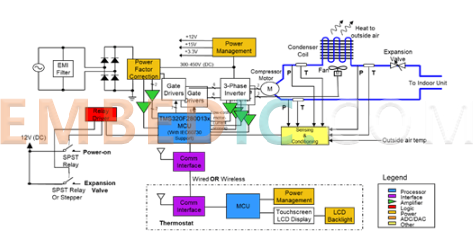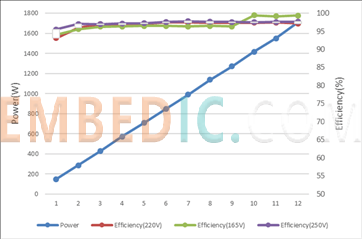More and more businesses and individuals are looking for ways to reduce their energy footprint and increase their use of renewable resources. What should we focus on in order to make a significant impact?
More than 65% of the world's electricity is used to power motors and power sources in industrial settings, commercial buildings and individual homes. According to Our World in Data, 60 percent of electricity comes from burning coal and natural gas, and less than 10 percent comes from renewable sources.
Intelligent inverter digital motor control can reduce energy consumption by more than 25 percent. Intelligent digital power control can increase the productivity of solar and wind energy and reduce the power consumption of ultra-high-energy devices to a greater extent. In this article, we will explore some of the trends in smart control applications, as well as share examples of how smart control can reduce energy consumption and improve renewable energy efficiency.
Air conditioners (Figure 1) are a major power-consuming device on the grid. While specific energy efficiency standards vary by region, all designs require the implementation of advanced motor control and power factor correction (PFC) algorithms to achieve target ratings and meet power factor specifications.
Controlling each motor (compressor, cooling fan) in an air conditioner may require a control loop that operates at up to 20kHz. PFC, on the other hand, typically requires operating frequencies of up to 50kHz. Therefore, in order to reliably implement multiple high-frequency control loops, microcontrollers (MCUs) must be able to process calculations quickly and efficiently with virtually no latency.

Figure 1.
MCUs for air conditioning systems require multiple analog-to-digital (ADC) and pulse-width modulation (PWM) channels to flexibly synchronize with switching events and independently sample and control two inverters and PFC circuits. Analog comparators and PWM interference cancellation are required for power electronics protection.
As required by IEC 60730, the MCU for air conditioning will also provide clock protection, including two on-chip oscillators with greater than 1% accuracy, as well as watchdog and clock fault detection circuitry.
The dual motor control reference design for air conditioners with digital interleaved PFC provides hardware and software examples of a single 64-pin C2000 TMS320F2800137 MCU that controls compressor and fan motors at 97% efficiency with a digital interleaved 72kHz boost PFC stage, providing 96% power efficiency (Figure 2) and many common system and communication functions.

Figure 2.
The C2000 real-time MCU architecture is optimized to reduce latency between detection (ADC), processing (CPU) and control (PWM), consuming only 40KB of flash memory and 30% of the central processing unit (CPU). According to TI benchmark testing, the Arm® Cortex®-M7F MCU needs to run at 240MHz to provide the same overall performance as our 120MHz device.
The reference design is scalable to single-motor and motor-enhanced PFC applications with smaller TMS320F2800137 series 48- or 32-pin packages and 64KB to 256KB on-chip non-volatile flash options. The reference design can also be used to improve the efficiency of virtually any motor in residential air conditioning system motors to variable-speed, variable-load systems, from low-voltage battery-powered devices in industrial applications to ultra-high-power AC drives.
For digital power supplies, the goal is to create renewable energy more efficiently, as well as to convert and use energy more efficiently. For example, the solar market tends to shift from centralized high-power PV inverters to distributed low-power solar systems, such as micro-inverters and power optimizers.
Typically, one of these microinverters and power optimizers is installed for every few solar panels and is used to produce lower energy losses and higher efficiency under complex daylight conditions. As more of these modular power electronics are added to solar systems, real-time MCUs need to be low-cost, but still powerful enough to perform maximum power point tracking for each solar panel under their control.
The growing demand for energy use worldwide has created a need for efficient, compact and stable power sources. This requirement has created a challenge for designers of power conversion systems: to provide a power-intensive design while meeting the efficiency and fast transient response requirements of "small enough but high performance" systems. In addition, the drive to digitize existing analog designs for increased scalability has also created the need for low-cost, high-performance real-time MCU solutions.
As a new addition to the C2000 real-time MCU family, the TMS320F2800137 helps reduce the cost of real-time technology and extends the long-term software-compatible platform to provide low-, mid- and high-level options for analog and digital designers. With this new family, engineers in motor control, grid infrastructure and industrial power applications can create products that both reduce their energy footprint and improve renewable energy utilization.
Manufacturer: Texas Instruments
IC DSP FIXED/FLOAT POINT 256BGA
Product Categories: DSP
Lifecycle:
RoHS:
Manufacturer: Texas Instruments
IC DSP FIX/FLOAT POINT 176HLQFP
Product Categories: DSP
Lifecycle:
RoHS:
Manufacturer: Texas Instruments
IC DSP FIX/FLOAT POINT 841FCBGA
Product Categories: DSP
Lifecycle:
RoHS:
Manufacturer: Texas Instruments
IC DSP FIX/FLOAT POINT 841FCBGA
Product Categories: DSP
Lifecycle:
RoHS:
Looking forward to your comment
Comment